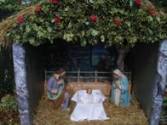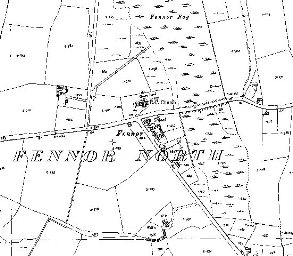Fenor 1996 – Diary of a Parish Community
“Mission Memories”
by ‘De La Rochelle’
21st April, 1996
Today was the start of a week-long mission in the parish given by the Capuchin Fathers, Father Christopher Twomey from Ballyvourney, Co. Cork, and Father Alexis Healy from Skibbereen. Father Christopher, who is based in Carlow, was our missioner for the week, and we grew to love him in that short period of time. Please God he will visit us again soon.
Mission Memories.
Away back in the first half of this century the announcement of a forthcoming mission was greeted and accepted with enthusiasm and was looked forward to by priests and people, perhaps not for the same reason. My first experience of a mission was away back in 1930. The preachers were Fathers Antonine and Cyril from the Franciscans in Waterford. Father Antonine was prior in Waterford at the time. He was a big, fairly stout man who played the organ and sang beautifully but, somehow, his preaching wasn’t considered exceptional. He wasn’t able to command the same attention as his colleague, Father Cyril.
The mission opened in Dunhill and went on for a week there. The exercises consisted of Mass each morning at 7:30 followed by a short instruction on the sacraments. The evening ceremony consisted of rosary, sermon and Benediction on alternate evenings. Although I was very young at the time, that mission left an impression on me that still remains to this day. The preacher used a text such as one of the Commandments or a passage from the Bible or some phrase that would command attention. Indeed, I can recall vividly the text of my first mission sermon as that man, small in stature with closely cropped hair and fringe down almost over his eyes, that was Fr. Cyril, opened his sermon with the text, ‘Mane, Teckle, Faraes’. It had an instant impact on the congregation. From that moment to the close of the mission he had those who were listening in the palm of his hand. He then went on to explain the meaning and origin of these three Latin words taken from the Old Testament. I have spoken of this latterly to clergy and laity and most of them never heard of it. So for the benefit of those, I will try to convey as best I can its meaning and origin.
King Balthasar of one of the Biblical countries, having proclaimed himself beyond the power of God, was mockingly feasting with great joviality and depravity, desecrating the sacred vessels that were used at the offering of sacrifice to God, and also denying the existence of God. When the revelry was at its peak, the fingers of a hand came forth against the wall and wrote, as if on sand, the words ‘Mane, Teckle, Faraes’. The king and his cohort were terrified and mystified as no one present knew their meaning. The king commanded that anyone who could translate their meaning should appear before him, but no one seemed to be able to translate their message. However, a young captive in the land came forward and revealed their meaning, which was that the king was to die and be replaced by one of his most deadly enemies. There was a great poem in the Old Testament of the event and I remember my father reciting it for us the following day. The proof of its impact must surely be that it has never been erased from my memory.

Then we had a mission in 1935 but I cannot recall anything about it. We had a mission in 1940 which I find easy to recall and, when it was announced, I remember how those of my age group considered it would interfere with our pursuit of the pleasures that were uppermost in the minds of young manhood and perhaps womanhood also, and some of us were devising ways of escaping from the preaching that might spoil the enjoyment of the pleasures of youth. But it was essential to attend the first night as our absence would be noticed. So, reluctantly, we went along and were hooked under the spell of that preacher. We attended all the exercises and felt edified and enriched by them. It was considered a very successful mission as acrimony between families and neighbours was healed by the sanctifying grace that seemed to encompass the parish and appeared to flow from every spring or well. There was also a sad tragedy that added further emphasis to one text used during the mission, when a man named Pat Power, better known as Pat Carroll, who had been to Mass and Holy Communion that morning, was gored to death by a bull when he went to collect the cows for evening milking. The parish was stunned. The sad occurrence left an impression of that mission never to be erased from the memories of those who were witness to it. I might add here that the text used at the opening of the mission was, ‘Watch ye therefore, for ye know not the day nor the hour’.
That mission was given by the Passionist Fathers. There was a mission in 1950 but, somehow, it doesn’t seem to have left an impression of any significance. Latter-day missions don’t seem to have the appeal of the missions of long ago.
The attendance at missions and their impact seemed to wane after Vatican II. Changes were taking place and the Church was changing its emphasis. The devil was getting less publicity now and was having to take a low profile. It took some of the punch out of preaching, and having no renegade or thief to chastise left the preacher somewhat short-changed and we all liked to see the devil getting hell.
The mission of 1996 will scarcely have left the same impression or have had the same impact on an eight or nine year old as my first mission had on me at that age. It was a lovely mission but the attendance left a lot to be desired. One was sorry for those who, like those in the parable of the Marriage Feast in the gospel, were too busy to take part in the feast and had other things to attend to. The contrast between the missions of 1940 and 1996 was very marked. In 1940 the mission would be the topic of every conversation for days before and weeks after taking place whereas, in 1996, many parishioners seemed unaware it was taking place.
However, in today’s climate, it would be unwise to judge the depth of people’s faith by attendance at church or religious practices as many of today’s people choose other ways and means to serve their God and find fulfilment.










